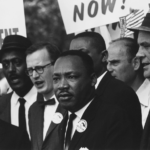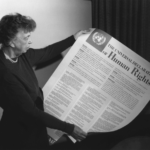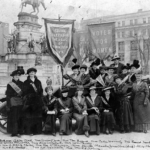In this lesson, students will learn about the individual rights that are included in the Bill of Rights and current issues relating to them. Students will use C-SPAN Classroom’s Constitution Clips to explore what each of these rights mean and determine how these rights apply to current events in America. This lesson works well with classes with one-to-one devices or in flipped classrooms.
Comparing the Magna Carta and English Bill of Rights with the U.S. Bill of Rights
In this activity students will examine the influences of the Magna Carta and the English Bill of Rights on the Bill of Rights in the U.S. Constitution. By the end of the activity students should be able to cite clear examples of the influence of English legal traditions in the U.S. Bill of Rights; they should also be able to give examples of how the American document is unique in offering even further expanded rights.
Freedom Summer 1964
Freedom Summer is a digital learning tool (available on the web or as an app) for teachers and students that explores key events surrounding this time in America’s history and the impact of the civil rights movement on civil rights legislation. Players predict the outcomes of civil and congressional actions and discover how the events are intertwined. Students have the opportunity to view informative intro and outro videos and analyze 20 primary sources depicting images of civil rights events. Analysis of a variety of primary sources and supplemental information leads students to identify varying perspectives and potential outcomes. Freedom Summer is formatted for all types of computers and mobile devices, including Chromebooks, and can be found on the website or in any app store for download.
Bill of Rights Booklet – Elementary and Middle Schools
Want your students to have their own Bill of Rights booklet? This booklet has the verbiage from the Bill of Rights and a space for students to be able to paraphrase what each amendment means.
Natural Rights, Citizenship Rights, State Rights, and Black Rights: Another Look at Lincoln and Race
In the real world, the ability of free blacks to enjoy their natural rights and exercise the privileges and immunities of citizenship depended on the states where they actually lived. When those states imposed a raft of legal discriminations on free blacks they cheapened the meaning of freedom and discounted the value of citizenship. I suspect this bothered Lincoln, but it wasn’t his issue. It would take other men and women, and another century of struggle, before “states rights” was abolished. Free registration for students and teachers required to access resource.
Freedom of Assembly: The Right to Protest
This lesson will focus on freedom of assembly, as found in the First Amendment. Students will consider the importance of the right to assemble and protest by analyzing cases where First Amendment rights were in question. Using the case National Socialist Party of America v. Village of Skokie, students will consider if the government is ever allowed to control the ability to express ideas in public because viewpoints are controversial, offensive, or painful. Students will use primary sources and Supreme Court cases to consider whether the courts made the correct decision in the National Socialist Party v. Skokie case. Students will be able to form an opinion on the essential question: Is the government ever justified to restrict the freedom to assemble?
March on Washington: Lesson Plans & Resources

On August 28, 1963, approximately 250,000 people participated in the March on Washington for Jobs and Freedom, which is considered to be one of the largest peaceful political rallies for human rights in history. Among other events, the march participants gathered at the Lincoln Memorial to hear Martin Luther King Jr. deliver his iconic “I Have a Dream” speech. Many consider The Great March on Washington to be the event that encouraged the passage of the Civil Rights Act of 1964 and the Voting Rights Act of 1965. The Share My Lesson team has created this collection of free lessons and classroom materials to help middle and high school educators teach their students about this historic event.
Teach Human Rights: Lesson Plans & Resources

The historical struggle for human rights is something that affects us, our children, and future generations as we fight for equity and inclusion in an increasingly torn society. It can also be difficult to speak with students about sensitive subjects, which is why this Share My Lesson collection provides expertly curated lesson plans, resources, and activities that define these rights, develop a global awareness, and teach how we can all make a difference when we act together.
Women’s Suffrage and Equal Rights: Lesson Plans and Resources

On August 18, 1920, the 19th Amendment to the United State Constitution was ratified, thus granting women the right to vote. The ratification of this amendment was a result of the powerful, unwavering momentum of hundreds of women who first convened a women’s rights convention in Seneca Falls, New York. This collection provides free lessons that will help students learn more about this important time in history, highlighting important developments in not only Women’s Rights, but U.S. Civil Rights and other amendments to the Constitution.
Do I Have a Right?: Bill of Rights Edition (Game and Teacher Guide)
In the Bill of Rights edition of Do I Have a Right? your students run a law firm that specializes in constitutional law, specifically the rights protected in the Bill of Rights. Clients bring various complaints, and students must identify if they “have a right.” As students successfully resolve cases by matching them with the correct attorneys, their law firm grows along with the skills of their lawyers.